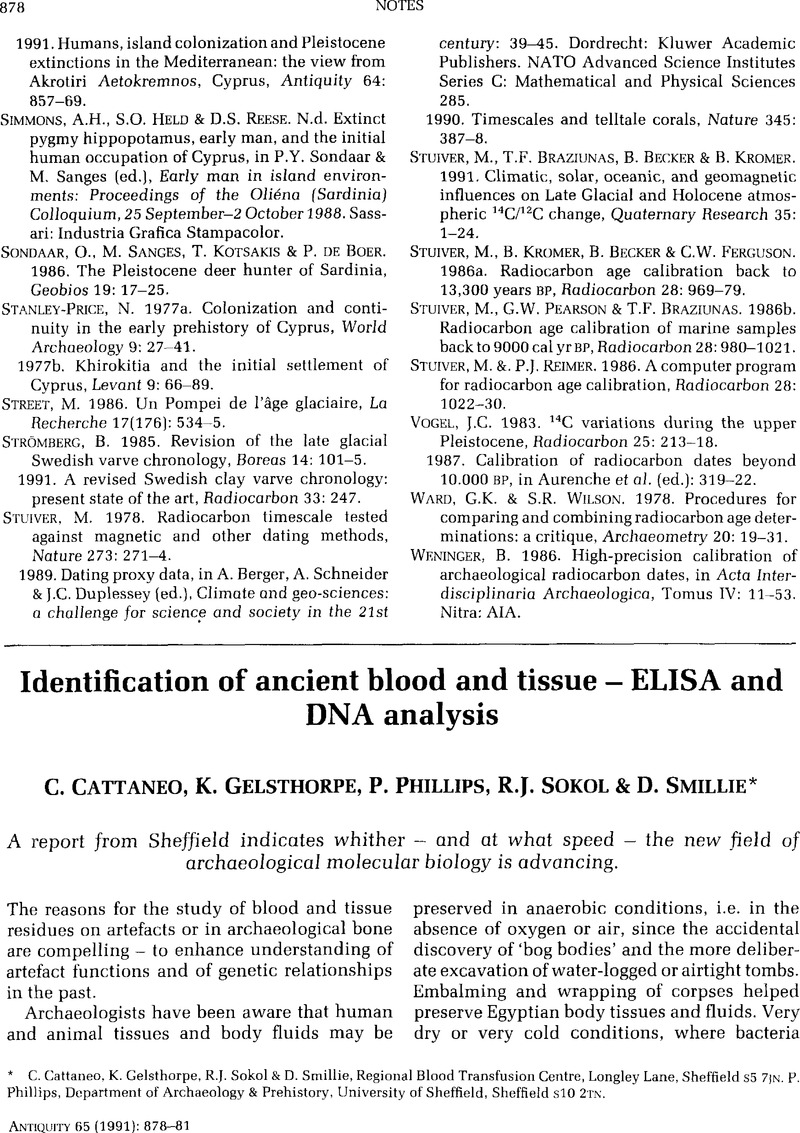Crossref Citations
This article has been cited by the following publications. This list is generated based on data provided by Crossref.
Fullagar, Richard
Furby, Judith
and
Hardy, Bruce
1996.
Residues on stone artefacts: state of a scientific art.
Antiquity,
Vol. 70,
Issue. 270,
p.
740.
Darvill, Timothy
2002.
‘It's better to dig than dance’: archaeological method and theory in ANTIQUITY 1927 – 2002.
Antiquity,
Vol. 76,
Issue. 294,
p.
1094.
Heginbotham, Arlen
Millay, Victoria
and
Quick, Michael
2006.
The Use of Immunofluorescence Microscopy and Enzyme-Linked Immunosorbent Assayas Complementary Techniques for Protein Identification in Artists' Materials.
Journal of the American Institute for Conservation,
Vol. 45,
Issue. 2,
p.
89.
Langejans, Geeske H.J.
2010.
Remains of the day-preservation of organic micro-residues on stone tools.
Journal of Archaeological Science,
Vol. 37,
Issue. 5,
p.
971.
Zheng, Qin
Wu, Xiaofeng
Zheng, Hailing
and
Zhou, Yang
2015.
Development of an enzyme-linked-immunosorbent-assay technique for accurate identification of poorly preserved silks unearthed in ancient tombs.
Analytical and Bioanalytical Chemistry,
Vol. 407,
Issue. 13,
p.
3861.
Dallongeville, Sophie
Garnier, Nicolas
Rolando, Christian
and
Tokarski, Caroline
2016.
Proteins in Art, Archaeology, and Paleontology: From Detection to Identification.
Chemical Reviews,
Vol. 116,
Issue. 1,
p.
2.
Wu, Meng
Zhang, Bingjian
Sun, Guoping
and
Jiang, Leping
2017.
Determination of lacquer contained in samples of cultural relics by enzyme-linked immunosorbent assay.
New Journal of Chemistry,
Vol. 41,
Issue. 14,
p.
6226.
Elie-Lefebvre, Delphine
Hartmann, Daniel
and
Balcar, Nathalie
2020.
L’envers de la marqueterie Boulle : analyse des matériaux de collage.
Technè,
Vol. 49,
Issue. ,
p.
89.
Li, Jiajia
and
Zhang, Bingjian
2020.
Study of identification results of proteinous binding agents in Chinese painted cultural relics.
Journal of Cultural Heritage,
Vol. 43,
Issue. ,
p.
73.
Han, Yeqing
Liu, Zijun
Huang, Xinduo
Wang, Yu
Zhang, Zhiguo
and
Pan, Jiao
2020.
The application of ELISA to the analysis and research of cementing materials in calligraphy of porcelain relics in Song Dynasty.
Microchemical Journal,
Vol. 159,
Issue. ,
p.
105530.
Wu, Qian
Zhang, Bingjian
and
Hu, Yulan
2023.
Comparison and Research Progress of Protein Detection Technology for Cultural Relic Materials.
Coatings,
Vol. 13,
Issue. 8,
p.
1319.
Li, Yanli
Ruan, Yuyao
Cailuotai
Suonanji
Liu, Panpan
Li, Yuhu
and
Xing, Huiping
2024.
Ontological analysis and disease statistics of wooden coffin paintings from the Qinghai Tibetan Medicine Culture Museum, China.
Heritage Science,
Vol. 12,
Issue. 1,
Wu, Qian
Zhang, Bingjian
Zhang, Qiong
Ma, Mingzhi
and
Hu, Yulan
2025.
Identify the genus origin of animal glue used in Chinese historical mortars using a new DNA mini-barcoding method.
Journal of Archaeological Science,
Vol. 181,
Issue. ,
p.
106305.


